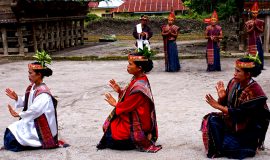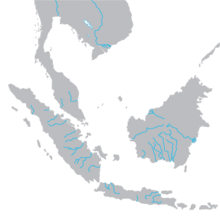

General Information About Sumatra
Sumatera - the westernmost and second largest island of Indonesia (approximately 473,970 sqm) is fringed with smaller islands off its western and eastern coasts. With 1,790 km in length and 435 km in width, the island has Bukit Barisan – a volcanic mountain range with more than 30 active volcanoes, traverses its length reaching 12,467 feet at Mount Kerinci.
Sumatra has something for everyone to explore – lush rainforests inhabited by exotic flora and fauna, cascading rivers, sparkling crater lakes, beautiful white sandy beaches, impressive volcanoes, limestone caves and an incredible diverse array of traditional ethnic groups who inhabit some of the most spectacular volcanic landscapes of the world.
Explore the legendary charm and highlights of North and West Sumatra where vast rainforests are inhabited by exotic wildlife, towering volcanoes dominate the skyline and scenic waterfalls gush down into verdant valleys by driving overland.
Lake Toba is one of the most awesome natural wonders of the world – a crater lake with the mystical island of Samosir at its centre and home to the Toba Batak; one of the ethnic groups predominantly found in North Sumatra including the Karo, Pakpak, Simalungun, Angkola and Mandailing; groups with distinct - albeit related - languages and customs. Toba Batak are known traditionally for their weaving, wood carving and especially ornate stone tombs. The area surrounding Lake Toba is home to many fascinating villages; each one the setting for performances of ancient dances.
Bukit Lawang, also in north sumatra is home to rainforests inhabited by exotic wildlife, framed by towering volcanoes and waterfalls cascading down into verdant valleys. In the village of Tangkahan, a team of elephants and their mahouts work together to maintain a fledgling national park, where visitors can join these gentle giants at work and play in the pristine rivers and jungle paths of the region. Just upriver, the village of Bukit Lawang is the perfect place to see orangutan in the wild. The apes here have grown used to human interaction, so expect some up close and personal encounters.
Aceh was dessimated by an earthquake and tsunami in December 2004, Aceh has since recovered, thanks to international aid and the indomitable spirit of the Acehnese themselves. Today, the region has been rebuilt and regenerated, and is emerging as one of Indonesia’s most rewarding new tourism destinations. Visitors can witness many poignant and dramatic relics of the disaster, from the area’s Tsunami Museum, to fishing boats on rooftops and a 12,000-ton trawler beached inland. Aside from tangible reminders of the disaster, Aceh is home to jungles teeming with wildlife, misty mountain peaks and endless swathes of empty beach, beyond which a heavenly halo of coral gardens is beckoning.
Pulau Weh, or Weh Island is kilometre zero for Indonesia; the westernmost outpost of the archipelago, with an otherworldy beauty befitting its remote location. Weh is home to white sandy beaches and breathtakingly blue ocean, framed by the curving arches of palm trees and bathed in warm sunshine. For those who love snorkelling, diving, or simply enjoying the picture-perfect escapism of a signature tropical island, Weh is the way to go.

Sports Played in Indonesia
Maecenas vitae turpis condimentum metus tincidunt semper bibendum ut orci. Donec eget accumsan est. Duis laoreet sagittis elit et vehicula. Cras viverra posuere condimentum.About Basketball Game
Sed aliquam nunc eget velit imperdiet, in rutrum mauris malesuada. Quisque ullamcorper vulputate nisi, et fringilla ante convallis quis. Nullam vel tellus non elit suscipit volutpat. Integer id felis et nibh rutrum dignissim ut non risus. In tincidunt urna quis sem luctus, sed accumsan magna pellentesque. Donec et iaculis tellus. Vestibulum ut iaculis justo, auctor sodales lectus. Donec et tellus tempus, dignissim maurornare, consequat lacus. Integer dui neque, scelerisque nec sollicitudin sit amet, sodales a erat. Duis vitae condimentum ligula. Integer eu mi nisl. Donec massa dui, commodo id arcu quis, venenatis scelerisque velit. Praesent eros turpis, commodo vel justo at, pulvinar mollis eros. Mauris aliquet eu quam id ornare. Morbi ac quam enim. Cras vitae nulla condimentum, semper dolor non, faucibus dolor. Vivamus adipiscing eros quis orci fringilla, sed pretium lectus viverra. Pellentesque habitant morbi tristique senectus et netus et malesuada fames ac turpis egestas. Donec nec velit non odio aliquam suscipit. Sed non neque faucibus, condimentum lectus at, accumsan enim. Fusce pretium egestas cursus. Etiam consectetur, orci vel rutrum volutpat, odio odio pretium nisiodo tellus libero et urna. Sed commodo ipsum ligula, id volutpat risus vehicula in. Pellentesque non massa eu nibh posuere bibendum non sed enim. Maecenas lobortis nulla sem, vel egestas dui ullamcorper ac. Sed scelerisque lectus sit amet faucibus sodales. Proin ut risus tortor. Etiam fermentum tellus auctor, fringilla sapien et, congue quam. In a luctus tortor. Suspendisse eget tempor libero, ut sollicitudin ligula. Nulla vulputate tincidunt est non congue. Class aptent taciti sociosqu ad litora torquent per conubia nostra, per inceptos himenaeos. Phasellus at est imperdiet, dapibus ipsum vel, lacinia nulla. Vestibulum ante ipsum primis in faucibus orci luctus et ultrices posuere cubilia Curae; Phasellus id interdum lectus, ut elementum elit.
Indonesia Culture and History
Culture Indonesia has about 300 ethnic groups, each with cultural identities developed over centuries, and influenced by Indian, Arabic, Chinese, and European sources. Traditional Javanese and Balinese dances, for example, contain aspects of Hindu culture and mythology, as do wayang kulit (shadow puppet) performances. Textiles such as batik, ikat, ulos and songket are created across Indonesia in styles that vary by region. The Indonesian film industry'spopularity peaked in the 1980s and dominated cinemas in Indonesia, although it declined significantly in the early 1990s. Between 2000 and 2005, the number of Indonesian films released each year has steadily increased. Indonesia holds 6 items UNESCO's Intangible Cultural HeritageHistory
Pre-historical era
Fossils and the remains of tools show that the Indonesian archipelago was inhabited by Homo erectus, popularly known as "Java Man", between 1.5 million years ago and as recently as 35,000 years ago. Homo sapiens reached the region by around 45,000 years ago. In 2011 evidence was uncovered in neighbouring East Timor showing that 42,000 years ago these early settlers were catching and consuming large numbers of big deep sea fish such as tuna, and that they had the technology needed to make ocean crossings to reach Australia and other islands. Austronesian peoples, who form the majority of the modern population, migrated to South East Asia from Taiwan. They arrived in Indonesia around 2000 BCE, and as they spread through the archipelago, pushed the indigenous Melanesian peoples to the far eastern regions. Ideal agricultural conditions, and the mastering of wet-field rice cultivation as early as the 8th century BCE, allowed villages, towns, and small kingdoms to flourish by the 1st century CE. Indonesia's strategic sea-lane position fostered inter-island and international trade, including links with Indian kingdoms and China, which were established several centuries BCE. Trade has since fundamentally shaped Indonesian history. In the mid first millennium A.D, Indonesian trader ships to Madagascar as well as eastern coast of Africa.Hindu and Buddhist kingdoms era

Indonesian Nightlife
Sed aliquam nunc eget velit imperdiet, in rutrum mauris malesuada. Quisque ullamcorper vulputate nisi, et fringilla ante convallis quis. Nullam vel tellus non elit suscipit volutpat. Integer id felis et nibh rutrum dignissim ut non risus. In tincidunt urna quis sem luctus, sed accumsan magna pellentesque. Donec et iaculis tellus. Vestibulum ut iaculis justo, auctor sodales lectus. Donec et tellus tempus, dignissim maurornare, consequat lacus. Integer dui neque, scelerisque nec sollicitudin sit amet, sodales a erat. Duis vitae condimentum ligula. Integer eu mi nisl. Donec massa dui, commodo id arcu quis, venenatis scelerisque velit.Popular Bars in Indonesia
L’Open Café
17, Rue des Archives - 75004 Paris Tel. : +33 (0) 1 42 72 26 18Bliss Kfé
30, Rue du Roi de Sicile - 75004 Paris Tel. : +33 (0) 1 42 78 49 36L’Oiseau bariolé
16, Rue Sainte Croix Bretonnerie - 75004 Paris Tel. : +33 (0) 6 10 38 46 51Le Cox
15, Rue des Archives - 75004 Paris Tel. : +33 (0) 1 42 72 26 18Famous Clubs in Paris
Six-Seven
65-67, Rue Pierre Charron - 75008 Paris Tel. : +33 (0) 1 58 56 20 50VIP room
76, Avenue des Champs-Elysées - 75008 Paris Tel. : +33 (0) 1 56 69 16 66Le Baron
6, Avenue Marceau - 75008 Paris Tel. : +33 (0) 1 47 20 04 01Le Latina Café
114, Avenue des Champs Elysées- 75008 Paris Tel. : +33 (0) 1 42 89 98 89

North Sumatra Highlights 24 Nov 2015 - 31 Dec 9999
- Samosir island tour
- Boat trip on Toba lake
- Trekking in Bukit lawang to see Orangutan
- Enjoy Sumatera culture

Medan City tour 07 Apr 2018 - 31 Dec 9999
- Visit the Royal Palaca of Sultan Deli, Maimoon Palace
- Visit the Mosque of Al-Maksum, the Great Mosque of Medan
- visit at Asam Kumbang Farm
- browse for antique at Kesawan Street

Explore North Sumatra 29 Apr 2020 - 31 Dec 9999
- Samosir Island
- Toba lake
- Tangkahan
- Bukit Lawang
- Medan










